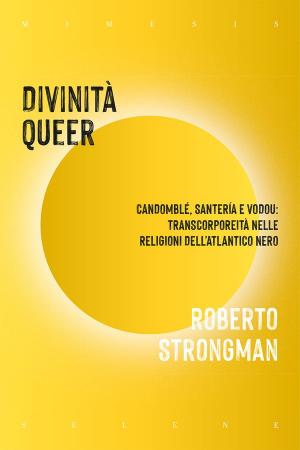Queering Black Atlantic Religions: Transcorporeality in Candomblé, Santería, and Vodou (Duke University Press, 2019)
Divinità Queer Candomblé, Santería e Vodou: transcorporeità nelle religioni dell’atlantico nero (Italian translation, 2023)
English Translation of Interview with Professor Strongman in Harper's Bazaar:
- How did the idea for this book come about?
The idea for the book emerged at the confluence of my abilities, gifts and talents and the needs of the communities of which I am a part. One the one hand, I had developed literary and cultural hermeneutical abilities and on the other were religious communities that have been maligned and unjustly persecuted. The book emerged at the point on which these lines converged. With that being said, I must also acknowledge that the book emerged as much from silence as it did from observation and participation. The autoethnographic project involves actively collecting data, and I did that. However, I also stood in front my topic in contemplation. This non-verbal reverence allowed the topic to speak to me. So, I recommend a deeply introspective stance towards scholarship: one that requires the self-knowledge to understand how one fits in relation to one’s project and to also have the ability to cultivate the quiet expectation that allows the project to reveal itself and its methods.
- Would you tell me more about the experience of transcripturality?
Transcripturality is then the way in which the project speaks to the researcher. It is complementary to the process of trance that the book examines since the project sort of take over the scholar, like the Divine does the devotee in the ritual context. So, I could say that the form of the book folds nicely into its function. Its recursivity underscores the more mystical aspect of the book: the idea that individuality is an illusion and that all is One.
- In your book one of the themes is that of transcorporeality, understood as an ethnopsychology that sees the self as "multiple, removable and external to the body that functions as its receptacle". Tell me more?
Yes, I noticed that none of my respondents were saying that “the spirit got into them” or that “the sprit entered their bodies.” This runs counter to way in which outsiders interpret the phenomenon of trance. So, asking some further questions, the initiates let me know that only their consciousness or awareness –not their egos, sense of self— were temporarily shed and that their bodies were manipulated by spiritual entities from without, from outside their bodies.
- This concept of the psyche or soul as multiple differs from Western philosophical studies of the soul as singular and internal to the body. Is there a synthesis between these two 'visions'?
Well, I think the most important lesson for us is that our relationship to our bodies is imagined and culturally learned. Most of these constructs are managed through metaphors such as the kernel-in-the-fruit or the horseback riding. Knowing this can free us from dogma and help us to create more original understandings of our bodies that can lead to more authentic and empowered lives.
- You also describe some forms of non-heteronormativity embodied in Vodou mythology. Can you tell me how you approached this and elaborate on some of them?
Regarding mythology: Many Afro-diasporic pantheons include sprits, called Orishas in the Yoruba religions and Lwas or Vodouns in trans-Atlantic Vodou, that are understood to have avatars that are male and female. Also many of these divinities can be hermaphroditic or displpay homoerotic attractions.
About non-heteronormativity: If gender is presumed to be part of your “soul” and this soul can be muted or replaced, then the devotees can be regendered by the experience, especially if the gender of the divinity differs from the devotee’s.
- Do you think it is possible to overcome a view of the body circumscribed by social and cultural values and influenced by social and general experience that constructs the worldview?
The human experience is ultimately social. So, in a strict sense I don’t think it is possible to have an identity apart from social relations. There are some limitations and rules built into the game. If we were to approach life as just a game, perhaps we could feel freer to train, to accept ourselves with our gifts and limitation, to take on the challenge and to be OK with winning and losing. This is freedom: knowing the parameters that demarcate our existence, bending those parameters, if possible, and ultimately working with what we have available—which is self-acceptance. Much of human suffering is brought upon by this lack self-acceptance and obsession to escape current conditions. Many people are so consumed with the desire of a physical unshackling that they forget that there is release in just Being.
- In your book, it emerges how the spirit and the human interact with each other. What is your relationship with spirituality?
Is this a personal question about my own spiritual practice? (Laugh!) My spirituality is very eclectic. I could spend an entire Saturday night at a Vodou ceremony in Pétionville and in the morning go to mass at the cathedral in Port-au-Prince. There is no contradiction in this for me. I revere Wisdom and both the Holy Spirit and Damballah / Obatalá are manifestations of this Virtue. I also participate in entheogenic Native American spiritual communities that partake of plant medicines as sacraments: Ayahuasca, San Pedro and Peyote. There is a strong element of Shaivism that emerges in my teaching and practice of yoga. My massage therapy practice is also informed by a Thai Buddhist spirituality. I don’t worship the methods—which is what religions ultimately are. I revere the That-ness (in Sanskrit: Tatva) that we all are.
Related Link:
October 31, 2023 - 11:22am

